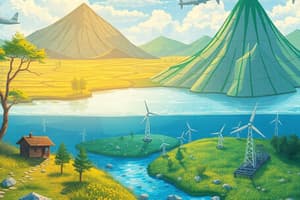Podcast
Questions and Answers
What is a disadvantage that fossil fuels and biomass have in common?
What is a disadvantage that fossil fuels and biomass have in common?
Carbon dioxide
Which element has 3 million times the energy of the same amount of coal?
Which element has 3 million times the energy of the same amount of coal?
Uranium
About how much of the electricity in the United States is produced using fossil fuels?
About how much of the electricity in the United States is produced using fossil fuels?
85%
Give three examples of fossil fuels.
Give three examples of fossil fuels.
What process is used to get diesel, octane, and other products from petroleum?
What process is used to get diesel, octane, and other products from petroleum?
List each of the 8 energy resources we covered in the table below. Write whether each is renewable or non-renewable (two of them can be "it depends").
List each of the 8 energy resources we covered in the table below. Write whether each is renewable or non-renewable (two of them can be "it depends").
What types of things are included in "biomass"?
What types of things are included in "biomass"?
Which type of alternative fuel has only water as a product when burned for energy?
Which type of alternative fuel has only water as a product when burned for energy?
What is a disadvantage of using hydrogen fuel cells?
What is a disadvantage of using hydrogen fuel cells?
What is an advantage of using nuclear fuel?
What is an advantage of using nuclear fuel?
What is a disadvantage of using nuclear fuel (Hint: Radioactive waste)
What is a disadvantage of using nuclear fuel (Hint: Radioactive waste)
What is the source of geothermal energy?
What is the source of geothermal energy?
What is the primary advantage of hydroelectric power?
What is the primary advantage of hydroelectric power?
Nuclear reactors convert thermal energy into mechanical energy to generate electricity.
Nuclear reactors convert thermal energy into mechanical energy to generate electricity.
What two types of radiation are commonly associated with radioactive decay?
What two types of radiation are commonly associated with radioactive decay?
The remaining amount of thorium-234 after 72 days is ______ g.
The remaining amount of thorium-234 after 72 days is ______ g.
Match the following energy sources with their attributes:
Match the following energy sources with their attributes:
Flashcards
Fossil fuels and Biomass disadvantage
Fossil fuels and Biomass disadvantage
Fossil fuels and biomass both release carbon dioxide as a byproduct when burned for energy, contributing to greenhouse gas emissions.
Geothermal energy source
Geothermal energy source
A type of energy extracted from the Earth's core, often found in areas with volcanic activity.
Wind energy source
Wind energy source
A renewable energy source that utilizes the power of moving air to generate electricity.
Hydroelectric energy source
Hydroelectric energy source
Signup and view all the flashcards
Solar energy source
Solar energy source
Signup and view all the flashcards
Nuclear energy source
Nuclear energy source
Signup and view all the flashcards
Fossil Fuel source
Fossil Fuel source
Signup and view all the flashcards
Biomass energy source
Biomass energy source
Signup and view all the flashcards
Hydrogen fuel cell advantage
Hydrogen fuel cell advantage
Signup and view all the flashcards
Hydrogen fuel cell disadvantage
Hydrogen fuel cell disadvantage
Signup and view all the flashcards
Fractional distillation
Fractional distillation
Signup and view all the flashcards
Nuclear fuel advantage
Nuclear fuel advantage
Signup and view all the flashcards
Nuclear fuel disadvantage
Nuclear fuel disadvantage
Signup and view all the flashcards
Petroleum processing
Petroleum processing
Signup and view all the flashcards
Uranium-235 energy density
Uranium-235 energy density
Signup and view all the flashcards
Fossil fuel renewability
Fossil fuel renewability
Signup and view all the flashcards
Biomass renewability
Biomass renewability
Signup and view all the flashcards
Nuclear energy renewability
Nuclear energy renewability
Signup and view all the flashcards
Fossil fuel electricity generation
Fossil fuel electricity generation
Signup and view all the flashcards
Half-life
Half-life
Signup and view all the flashcards
Where does the energy from hydroelectric power come from?
Where does the energy from hydroelectric power come from?
Signup and view all the flashcards
What is the energy from a nuclear reactor used for?
What is the energy from a nuclear reactor used for?
Signup and view all the flashcards
What are three types of radiation?
What are three types of radiation?
Signup and view all the flashcards
What is fractional distillation?
What is fractional distillation?
Signup and view all the flashcards
Study Notes
Fossil Fuels and Energy Resources
- Fossil fuels (coal, oil, natural gas) are non-renewable energy sources
- 85% of US electricity comes from fossil fuels
- Petroleum is processed using fractional distillation
- Fossil fuels release carbon dioxide
- Uranium-235 has much higher energy density than coal
Biomass
- Biomass includes wood, soy, corn, and rice hulls
- Biomass is a renewable energy source
- When burned, biomass produces carbon dioxide
Alternative Fuels
- Hydrogen fuel cells produce only water as a byproduct
- Hydrogen fuel cells are expensive and require a significant amount of energy
Nuclear Energy
- Nuclear fuel produces zero greenhouse gas emissions during use
- Nuclear fuel produces radioactive waste, a significant disadvantage
Geothermal Energy
- Geothermal energy comes from heat inside the Earth
Studying That Suits You
Use AI to generate personalized quizzes and flashcards to suit your learning preferences.




